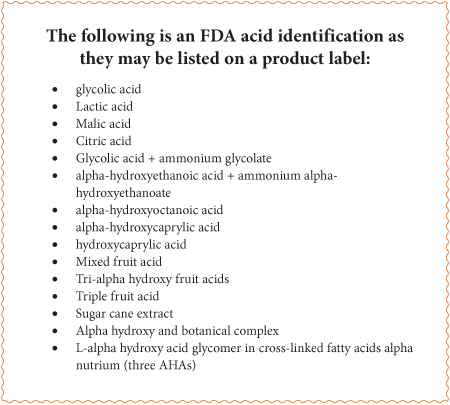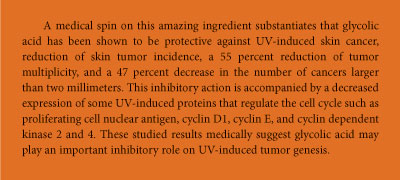My position is to clear up the continued confusion and misunderstanding as it relates to AHAs and I submit myself as an expert on the subject of acids as a science based professional product formulator, licensed Master Esthetician, and how acids relate to various conditions of the skin to achieve end point results with my 20+ years of experience using this ingredient.
What is an AHA Acid?
Alpha hydroxy acids are a group of organic acids that vary in the number of carbon molecules. The information available on these very studied ingredients could fill the Library of Congress. Hydroxy acids are organic carboxylic acids classified into A- and B- types (AHA, BHA) according to their molecular structure. Both AHAs and BHAs exhibit similar effects, however AHAs are classified as a ‘wounding agent’ and BHAs are recognized as “non-wounding agent” by the chemistry of their action on the skin. Chemical structure and natural source AHAs range from simple aliphatic compound to complex molecules. All have a hydroxyl group attached to the alpha carbon (the carbon adjacent to the acid group). The shortest-chain AHA is glycolic acid, which possesses two carbons causing a rapid Stratum Corneum (SC) cascade of epidermolysis (a separation of the epidermal cells that can detach at the epidermal/dermal junction) and erythematic reaction. Lactic acid owns three carbons with less irritation however the benefits of this acid are substantiated and recommended as an effective tool for dry, acne, and pigmented skin because it provides NMF (natural moisturizing factor) comprised of 40 percent amino acids. According to Smith’s data on turnover and irritation, Lactic acid’s long-term benefits increase firmness by 35 percent, hydration by 23 percent, smoothness by 23 percent, wrinkles by 55 percent, and collagen by 210 percent. Lactic acid contains NMF, which is known to hold onto water at the skin’s surface by binding hydration in place, signaling and assisting the skin proteins to better absorb moisture. NMF consists primarily of amino acids, a component of the important peptide chains and acid mantle. Given the differences of carbon structure and components of glycolic and lactic, these two related acid chemicals are the most commonly used AHAs in professional skin peeling and skin care formulas for anti-aging, rosacea, acne management, and pigment control in retail end-user products. Other acids also efficacious and used for skin peeling and skin care products are identified by the terms: malic acid, citric acid, tartaric acids, alpha hydroxy acid (ethanoic, octanoic, or caprylic), pyruvic acid, TCA, Retinol, mixed fruit acid, triple fruit acid, sugar cane extract, and any ingredient that includes the words “alpha-hydroxy” (e.g., tri-alpha-hydroxy fruit acids).

AHAs are naturally present in foods. As an example, sugar cane contains glycolic acid and sour milk contains lactic acid. Malic, citric, and tartaric acids are found in fruits such as grapes, lemons, and apples.
The main principle of using acids on the skin is to remove surface proteins, mainly corneocytes, by denaturing the adhesive protein bonds between these cells to cause ‘a controlled injury’ disrupting the acid mantle barrier. Proteins are complex biochemical compounds made of amino acids and the structure and function of a protein is determined by the sequence of amino acids that make up the protein.
AHAs have no known systemic toxicity and are also classified as an antioxidant that scavenge free radicals. It has been reported these acid constituents can actually boost the skin’s SPF capability.

AHAs have had a long and successful history that can be traced back thousands of years. Spoiled wine contains tartaric acid and was used for cosmetic purposes by women in the court of France. Women in ancient Rome used the sludge from wine barrels to prepare facial masks. Cleopatra was reputed to have bathed in spoiled milk (most likely for its lactic acid content). Given this long history, after 40 years of dermatologic application AHAs were “rediscovered” in the late 1980s for their anti-aging benefits. This anti-aging epiphany quickly became the tripwire directly responsible for AHAs to become an integral ingredient into thousands of skin rejuvenation products refueling the skin care industry and spawning a plethora of new companies. Since then, the skin care industry has never been the same.
Typically, AHA products sold to consumers have an AHA concentration of 10 percent or less in over-the-counter products, or higher strengths in controlled professional environments. Safety of all acid ingredient use in any concentration is always the goal at any percentage level with emphasis on SPF protection. The concentration of AHA peeling solutions and treatment products used by trained and licensed aestheticians may range between 20 to 50 percent, depending on state licensing regulations, while those used by doctors can vary in upwards to 70 percent. Given the ability of higher acid activity for complete epidermolysis, it is important to note even low concentrations can cause the reduction of SC cohesiveness of cells, thereby discharging corneodesmosomes and desmosomes, resulting in compacting the SC. This acid action can be completely neutralized and stopped by water dilution.
In 1997, the Cosmetic Ingredient Review Panel – the cosmetic industry’s self-regulatory body for reviewing and addressing safety of cosmetic ingredients – concluded that the AHAs glycolic acid and lactic acid and their related chemical compounds are safe for use in products intended for consumer use when:
- The AHA concentration is 10 percent or less.
- The final product has a pH of 3.5 or greater (lower numbers indicate greater acidity).
- The final product is formulated in such a way that it protects the skin from increased sun sensitivity or its package directions tell consumers to use sunscreen products.
For AHA products used by trained and licensed cosmetologists and aestheticians, the Cosmetic Ingredient Review Panel concluded that formulations of glycolic acid and lactic acid at concentrations of 30 percent or less and a pH of 3.0 or greater intended for only “brief” use at one time followed by thorough rinsing of tepid water and daily use of sun protection are safe guidelines. Many states still follow this principle. However, because the Cosmetic Ingredient Review Panel is not law, many boards have set their own guideline parameters of acid use that vary from state to state. Utah allows higher percentages; however this state established the first Master Esthetician license in 2000 requiring strict guidelines of education and use of the acids in a professional environment.
The FDA position on Acids
FDA has considered evidence that suggests that topically applied cosmetic products containing AHAs as ingredients may increase the sensitivity of skin to the sun, while the products are used and for up to a week after use is stopped, and that this increased skin sensitivity to the sun may increase the possibility of sunburn. The purpose of this guidance is to educate consumers about the potential for increased skin sensitivity to the sun from the topical use of cosmetics containing AHAs as ingredients and to educate manufacturers to help ensure that their labeling for cosmetic products containing AHAs as ingredients is not false or misleading. As an interim measure, while FDA continues to review the data on AHAs to address the potential for this increased skin sensitivity to the sun, FDA is recommending that the labeling of a cosmetic product containing an AHA as an ingredient that is topically applied to the skin or mucous membrane bear a statement that conveys the following information. The information in the AHA labeling statement is consistent with FDA’s current thinking on sun protection.
Sensitivity to UV radiation is the main reason for the skin’s sensitivity to the sun. Short-term exposure to the sun may cause sunburn and chronic long-term exposure to the sun may increase risk of premature skin aging. Experimental and epidemiological studies have demonstrated that prolonged exposure to the UV radiation in sunlight is a primary risk factor for certain types of skin cancer.
The human clinical studies reviewed by the Cosmetic Ingredient Review Expert Panel, FDA’s AHA Review Committee, and FDA provided data for the effects of UV radiation on the skin after short-term (up to 12 weeks) topical exposure to AHAs. Adverse experience reported by consumers of increased sunburn after AHA use were less than 100 reported incidents out of the millions of users, at the time this review, which hardly bears notice. No one knows if these consumers used SPF protection or not. Given that, AHA ingredients were the first revolutionary ‘cosmeceutical’ to claim significant anti-aging results without a prescription and because of this, AHAs were bound to capture the attention of the FDA and other regulatory agencies. It is important to note that even without the use of AHAs, the increased skin sensitivity to UV radiation may also result in other harmful effects to the skin.
The FDA acid guideline concludes these ingredients safe. Prudent professional action when advising on a home care product or in-clinic treatment options that include the use of AHAs must always ensure SPF protection of the skin and to advise your client of the same.
How is AHA Acid Strength Measured?
All skin care professionals should understand the basics in chemistry when working with these acids and applying them to the skin. Peel solutions in varying pH, acid type, pKa, and percentages produce a controlled partial thickness injury, insulting the skin to generate a wound healing process from the surrounding epithelium and adnexal structures that reorient new dermal connective tissue.
First and foremost, acid strength relates to the importance of pKa, which is a measure of acid strength and free acid availability. The pKa is the logarithmic expression of the pH at which the acid possesses ‘free acid’ containing equal amounts of ion and salt. The pKa has significant relevance in the use of acid because it informs you of the pH required for an efficacious peeling solution and outcome. For example, an acid with a pH of 3.5 and a pKa at 3.0 denotes the solution will have more salt than acid. Salt has no value in an acid solution and can only cause more irritation.
The smaller the value of the pKa the easier it is to remove the proton the stronger the acid; the larger the value, the weaker the acid. pKa is a measure of acid strength. The following list provides pKa value that pertains to the most commonly used acids in the professional environment.
Glycolic Acid pKa 3.83
Lactic Acid pKa 3.86
Pyruvic Acid pKa 2.49
Citric Acid 3.13
Salicylic Acid 3.0
TCA 0.26
Resorcinol 11.27
Acids, bases, and salts are among the most important chemical compounds used by chemists. Acids, bases, and salts contain ions of the element hydrogen. Ions are atoms or molecules that have lost or gained electrons. If atoms lose one or more electrons, they become positively charged ions (cations). If atoms gain one or more electrons, they become negatively charged ions (anions). It is the presence of the hydrogen ions in solutions that allow us to measure the pH of a solution. The quantity of hydrogen or hydroxyl ions in a solution determines whether the solution is acid or alkaline.
In 1909, Danish biochemist S.P.L Sorensen proposed the use of a logarithmic scale to express the concentration of hydrogen ions (H+) and hydroxide ions (OH-). This scale has become known as the pH scale. Sorensen knew that water had a nearly balanced concentration of positive (H+) and negative (OH-) ions.
The hydrogen ion concentration was found to vary over 14 powers of 10. A change of one pH unit changes the hydrogen ion concentration by a factor of 10. For example, a solution with a pH of one has 10 times more hydrogen ion concentration than a pH of two; 100 times more hydrogen ion concentration than a pH of three and so forth. This means that a solution with a pH of one has one million times more hydrogen ion concentration than a pH of seven. This information is extremely important when evaluating the pH power of professional peeling acids, which can vary from 1.5 to 4.0. The pH of a neutral solution is seven, such as water and the explanation why an acid’s activity can be stopped when neutralizing the AHA’s action on the skin. Thus the range of acid pH values extends from zero to seven, and that of alkaline values from seven to 14. Using acid peels is all about the hydrogen ion.
The skin has a pH value which serves to differentiate between acids and alkalis. The average of the skin’s pH is between 5.5 – 6.8 and will fluctuate. A neutral pH value is seven. The pH scale is between a 0-14 and most acid peels available in the professional environment are 3.0 or lower. The lower the pH the more active the acid peeling solution.
A salt is the combination of an anion (- ion) and a cation (+ ion). Another way to think of a salt is the combination of the ‘anion’ (negative charge) of a certain acid combined with the ‘cation’ (positive charge) of a certain base. The neutralization of potassium hydroxide with hydrochloric acid produces water and the salt, potassium chloride. In a solid salt, the ions are held together by the difference in charge. Solid salts usually make crystals, sometimes including specific molar amounts of water, called water of hydration into the crystal. If a salt dissolves in water solution, it usually dissociates (comes apart) into the anions (negative) and cations (positive) that make up the salt. Salt does not increase acid strength in an AHA skin treatment; in fact it can only add to the irritation effect. The more salt you have in your acid, the less potent it is and potentially the more irritating it can be. This ‘irritation’ reaction should send a red flag to the professional aesthetician to check out the AHA product they are using to ensure the normal “erythema” end-point benchmark is attributed to acid activity or abnormal salt irritation. For this reason alone this fact is important to know your pKa and pH value to ensure your AHA peel is correctly formulated. If a manufacturer will not provide you the pH of the peel you use, change suppliers.
A specific pH value signifies how much H+ is in an acid solution. To increase the pH value from a pH 3.0 to pH 4.0 the H+ should be reduced to remove some H+. The only way to do this is to add a ‘base’ substance with a higher pH.
The pKa value tells you at what pH you have half acid and half salt. This translates that if you buffer an acid, you convert some of the acid to the salt form. Buffers and neutralizers are often confused. Buffers are used to stabilize a pH. Neutralizers inactivate an acid substance. When the pH is lower than the pKa, regardless of concentration, you have more acid than salt in a buffered acid solution. Acid solutions are “buffered” not to make the acid stable but to raise the pH. The concentration is not as important as the pH and the pKa. I am asked all the time ‘what is the acid percentage concentration?’ Percentage of acid concentration is irrelevant and understanding this ‘acid chemistry’ explains why TCA, or trichloracetic acid (pKa of .26) will be far stronger in a five percent solution than lactic acid (pKa 3.86) or glycolic acid (pKa 3.83) at 30 percent. This is primarily because TCA is almost fully ionized and lactic and glycolic acids are not.
Gaining the most basic understanding of this ‘acid chemistry’ will provide you insight to how these ingredients work and why the concentration of acid, purity, delivery system, pH, pKa, de-fatting agent, and peel time influence if your acid peel will be effective or not. The benefit of these elements directly wounds the epidermis and impacts the upper reticular dermis and duration of exposure, benchmarked by the erythema reaction, will visually provide depth impact of light, medium, or deep.
Aestheticians and all skin care professionals must understand this most basic acid chemistry principal coupled with skill to make intelligent decisions applicable to the type, condition, and ethnicity of the skin when applying AHA peels. For this reason alone, know your manufacturer and ensure education in AHA peeling is part of their educational curriculum and continue your training indefinitely in this subject.
An inducted Legend in American Aesthetics by DERMASCOPE Magazine and Aesthetics International Association in 2008, Christine Heathman has been a practicing licensed master aesthetician, educator, and a leader in the research and development of skin care and progressive clinical protocols for over 25 years. A recent testimonial to Heathman’s skin knowledge selected her amazing product formulas out of thousands and recently featured them on the nationally syndicated TV show called The Doctors, as an alternative option to cosmetic surgery. www.glymedplus.com
